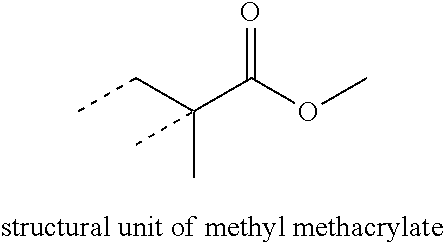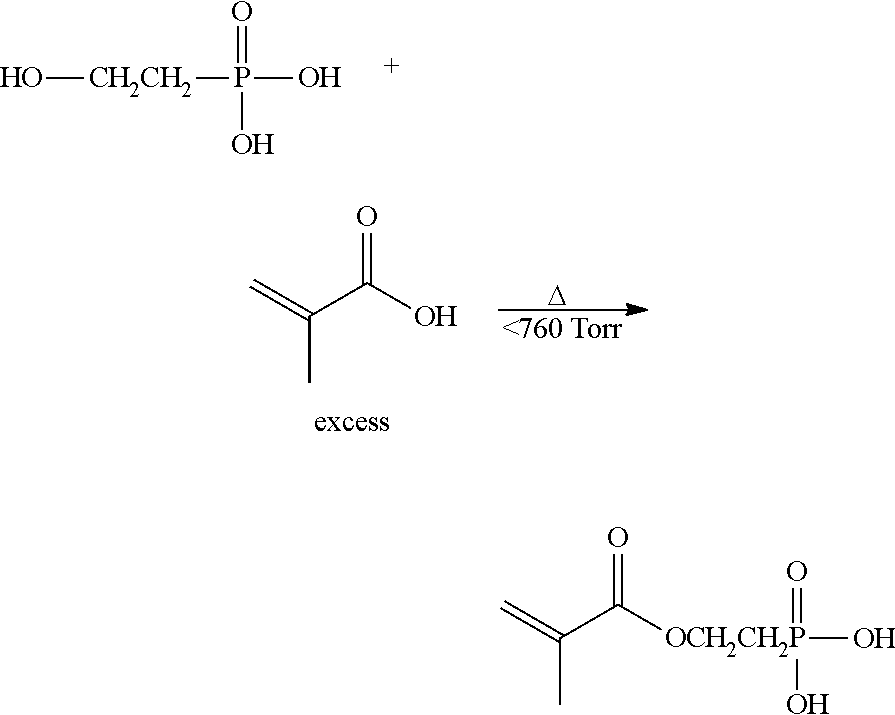Stable aqueous dispersion of particle polymers containing structural units of 2-(methacryloyloxy)ethyl phosphonic acid and composites thereof
a technology of ethyl phosphonic acid and stable aqueous dispersion, which is applied in the direction of coatings, etc., can solve the problems of limiting the utility of the monomer in applications, the purity of the pem is not high, and the process is not considered commercially viable, etc., to achieve high yield and purity, and the effect of rapid production
- Summary
- Abstract
- Description
- Claims
- Application Information
AI Technical Summary
Benefits of technology
Problems solved by technology
Method used
Image
Examples
example 1
Preparation of MEP-Containing Latex Particles
[0024]A first monomer emulsion was prepared by mixing deionized water (200 g), Disponil FES 993 anionic surfactant (28.25 g, 30% active), butyl acrylate (285.6 g), methyl methacrylate (202.32 g), 2-(methacryloyloxy)ethylphosphonic acid (16.11 g, 95% active), and sodium 4-vinylbenzenesulfonate (7.53 g, 90% active). A second monomer emulsion was prepared by mixing deionized water (420 g), Disponil FES 993 anionic surfactant (28.75 g, 30% active), butyl acrylate (666.4 g), methyl methacrylate (511.65 g), sodium 4-vinylbenzenesulfonate (3.78 g, 90% active), and ureido methacrylate (17 g, 50% active).
[0025]To 5-L, 4-necked round bottomed flask equipped with a paddle stirrer, a thermometer, a nitrogen inlet, and a reflux condenser was added deionized water (900 g) and Disponil FES 993 anionic surfactant (17 g, 30% active). The contents of the flask were heated to 84° C. under N2 and stirring was initiated. A portion of the first monomer emulsio...
example 2
Preparation of MEP-Containing Latex Particles with Acorn Morphology
[0038]A. Preparation of the Pre-Form
[0039]A first monomer emulsion was prepared by mixing DI water (200 g), Disponil FES 993 anionic surfactant (21.3 g, 30% active), butyl acrylate (371.2 g), methyl methacrylate (213.15 g), allyl methacrylate (9.6 g), 2-(methacryloyloxy)ethylphosphonic acid (35.0 g, 95% active), and methacrylic acid (12.8 g).
[0040]To a 5-liter, four-necked round-bottom flask equipped with a paddle stirrer, a thermometer, N2 inlet, and a reflux condenser was added DI water (600 g) and Disponil FES 32 anionic surfactant (64 g, 30% active). The contents of the flask were heated to 85° C. under a N2 atmosphere, and stirring was initiated. A portion of the first monomer emulsion (70 g) was then added, quickly followed by addition of an aqueous solution of sodium persulfate (2.56 g in 30 g DI water) and a further rinse with deionized water (5 g). After stirring for 10 min, the remainder of the first monome...
PUM
| Property | Measurement | Unit |
|---|---|---|
| Temperature | aaaaa | aaaaa |
| Temperature | aaaaa | aaaaa |
| Percent by mass | aaaaa | aaaaa |
Abstract
Description
Claims
Application Information
 Login to View More
Login to View More - R&D
- Intellectual Property
- Life Sciences
- Materials
- Tech Scout
- Unparalleled Data Quality
- Higher Quality Content
- 60% Fewer Hallucinations
Browse by: Latest US Patents, China's latest patents, Technical Efficacy Thesaurus, Application Domain, Technology Topic, Popular Technical Reports.
© 2025 PatSnap. All rights reserved.Legal|Privacy policy|Modern Slavery Act Transparency Statement|Sitemap|About US| Contact US: help@patsnap.com


